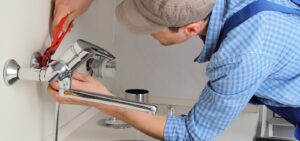▷How To Install Faucets At Residential Building In San Diego?
How To Install Faucets At Residential Building In San Diego?
Faucet installation might not be the first thing that comes to mind when you think of home improvement projects, but it’s an essential skill for any homeowner or DIY enthusiast. Whether you’re replacing an old faucet or installing a new one, knowing the right techniques can make the process smoother and more efficient. In this article, we’ll explore five ways to install faucets at residential buildings.
Preparation is Key
Before you even start installing a faucet, it’s crucial to gather the necessary tools and materials. You’ll need an adjustable wrench, pipe wrench, Teflon tape, a basin wrench, a bucket, and a flashlight. Make sure to turn off the water supply to the faucet you’re replacing, and open the faucet to release any remaining water. This will help prevent leaks and make the installation process much cleaner.
Single-Handle Faucet Installation
Single-handle faucets are common in modern homes due to their convenience and sleek design. To install one, start by attaching the faucet’s base plate to the sink or countertop. Next, connect the supply lines to the faucet’s inlet valves. Use Teflon tape on the threads to ensure a watertight seal. Tighten the connections with an adjustable wrench, but be careful not to overtighten and damage the fittings. Finally, turn on the water supply and check for any leaks. Adjust the handles and spout as needed for proper alignment.
Double-Handle Faucet Installation
Double-handle faucets may require a bit more effort but are still manageable for most DIYers. Begin by attaching the faucet’s base to the sink or countertop and connecting the supply lines to the inlet valves. Again, use Teflon tape to seal the connections and avoid leaks. Once everything is in place, turn on the water supply and test the faucet. Adjust the handles for hot and cold water as needed to achieve the desired temperature.
Wall-Mounted Faucet Installation
Wall-mounted faucets add a touch of elegance to your bathroom or kitchen, but they can be trickier to install. First, measure and mark the desired height for the faucet on the wall. Then, install a support bracket to hold the faucet in place. Next, connect the supply lines to the faucet’s inlet valves and secure them with Teflon tape. Once everything is connected, turn on the water supply and check for leaks. Wall-mounted faucets require precise measurements and careful planning, so take your time to ensure a proper installation.
Outdoor Faucet Installation
Outdoor faucets, also known as hose bibs, are essential for watering your garden and outdoor cleaning tasks. To install one, start by choosing a location that is easily accessible and close to the water supply. Dig a hole deep enough to accommodate the faucet’s frost-free spigot, making sure to slope it slightly away from the house to prevent water from pooling. Connect the faucet to the water supply, insulate the pipe, and secure it in place. Finally, attach a hose to the spigot and turn on the water supply to test for leaks.
FAQs
Can I Install A Faucet Myself, Or Should I Hire A Professional Plumber?
While faucet installation is a manageable DIY project for many homeowners, it depends on your comfort level with plumbing tasks. If you’re unsure or have any doubts, it’s always a good idea to consult a professional plumber to ensure a safe and leak-free installation.
What Should I Do If I Encounter A Leak After Installing A Faucet?
If you notice a leak after installing a faucet, first turn off the water supply to prevent further damage. Check the connections for loose or improperly sealed fittings. Tighten any loose connections and reapply Teflon tape if necessary. If the issue persists, consult a plumber for a thorough inspection and repair.
How Often Should I Replace My Faucets In A Residential Building?
The lifespan of faucets varies depending on their quality and usage. High-quality faucets can last for 15-20 years or more, while cheaper ones may need replacement sooner. If your faucets show signs of corrosion, leaks, or reduced functionality, it’s a good time to consider replacement to prevent further issues.
Call Home Pro Plumbing at (858) 251-7070 for a free consultation if you think there may be a water leak, or use our website to contact us.
Conclusion
Home Pro Plumbing offers tools like subsurface cameras for inspecting pipelines for leaks that you can’t even see. We are experts at fixing hidden plumbing issues and we know where to look for common issues. Even better, we offer yearly safety and plumbing inspections so that we may identify potential problems before they even materialize.
Give Home Pro Plumbing a call right away to learn more about how our experts can help with leak detection in San Diego, CA.
Our Plumbing & Leak Detection Services
Related Posts

▷5 Benefits of Hydro Jet Plumbing: A Comprehensive Guide In San Diego
5 Benefits of Hydro Jet Plumbing: A Comprehensive Guide In San Diego Hydrojet plumbing is a…

▷Essential Tips for Installing a Heat Pump Water Heater In San Diego
Essential Tips for Installing a Heat Pump Water Heater In San Diego Did you know that…

